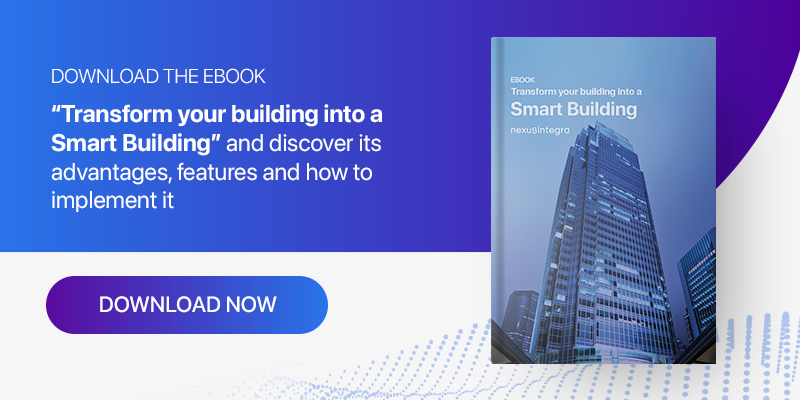Energy efficiency in buildings is the rational use of energy to supply the needs of a building such. It includes many activities such as lighting, ventilation, air conditioning, heating, production of hot water. It doesnt matter if the building, is new or old. It can can be public or private, including homes, offices, hospitals, airports, schools, shopping malls, public transport stations or city halls.
Currently, many people do not know for sure how much energy a building consumes per year and per square meter. The data could surprise you! We agree with William Thomson Kelvin’s famous phrase: “What cannot be measured, cannot be improved”. The gas or electricity expenditure of a traditional building is visible at the moment of receiving the bill after consumption. At that moment it is not possible to manage any saving measure, but only a disbursement measure. This is one of the biggest differences that exists with a Smart Building where the consumption of any energy source is controlled in real time and immediate actions can be taken to save money.
Energy efficiency in buildings focuses to implement efficient solutions to achieve almost zero energy consumption, without sacrificing the comfort of users in their daily activities. The main objective is to reduct the energy bill and also the environmental impact.
Calculating the energy efficiency of a building
The energy efficiency of a building is calculated by measuring the energy consumed during a year under normal operating and occupancy conditions. Energy consumption is expressed in kilowatt hours per square meter (kWh/m2 year).
According to the “Methodology for Calculating the Energy Efficiency Rating” of the Ministerio de Industria, Energía y Turismo of Spain, the main energy indicator will be the annual CO2 emissions, indicated in kg per m2 of useful surface area of the building. It should be noted that there are other complementary indicators such as the annual use of non-renewable primary energy, the energy demand for heating and cooling.
Based on the calculation of energy efficiency, the energy certificate of a building is obtained. The score is expressed from A to G. The highest rating is the letter A, which is equivalent to an efficient property that consumes up to 90% less energy compared to one that is rated at a lower level.
Building design
The first step to achieve energy efficiency in buildings is to thoroughly analyze the architecture and design. It has to include the orientation of the building, the impact of the sun, wind and humidity. At the structural level, it must be examined:
- The insulation of facades, walls, roof and floor type of windows.
- The type of windows, ideally double glazing should be used to avoid heat loss.
- Hermetic door frames.
- Possible heat losses in the building.
- Water wastage and also in terms of lighting, security cameras or any electronic equipment.
Also, depending on the orientation of the building, consider the possibility of installing solar thermal panels or other clean alternative energy source.
Actions to improve energy efficiency in a building
It is necessary to implement a comprehensive set of measures to improve energy efficiency in a building, some actions to take into account are:
- Periodic preventive maintenance of the air conditioning and heating system. A poorly regulated boiler can cause a waste of energy and money.
- Renewal of energy-related systems, taking into account the useful life of the assets. For example, with good maintenance a boiler can reach 10-15 years of useful life, depending on the model.
- Implementation of renewable energies such as solar panels.
- Use of LED bulbs that consume less energy and generate practically no heat.
Good management of energy resources by users plays a fundamental role. By consuming better, less energy is consumed. Awareness of the environmental impact of their daily actions is vital to consume energy rationally and carefully. However, it is not advisable to rely on people’s self-management because, depending on their busy schedules, they may omit energy-saving activities such as turning off the lights or air conditioning at the end of the working day, for example.
Technological solutions for real-time control
Currently, it is possible to implement technological solutions for the management and control of the processes that require energy consumption in a building. In this way it is possible to transform traditional buildings into intelligent ones. These solutions are based on Big Data, using sensor devices that connect the assets of a building to a digital platform in real time.
Automating repetitive energy processes in a building will optimize energy performance and significantly reduce electricity and gas costs.
Smart Buildings can now control from a single digital platform the different assets that consume energy:
- Room climate control: depending on the outside temperature, the temperature inside the building is self-regulated. Temperature management is not something new, but it is already possible to control all the floors of a building centrally with these new technologies.
- Irrigation systems: for monitoring, automating irrigation based on hours and even on the realtime humidity reported by the sensors. This application is very useful in golf courses, soccer fields and other sports facilities that need a detailed and optimized control.
- Lighting: lighting of light bulbs according to the amount of natural light or by time slot of activities in offices, town halls, factories, etc. It is also possible to manage manually from the platform the different areas of the building that are being monitored.
- Photovoltaic energy: in addition to the electrical grid, it is possible to control the extent to which this energy is used in those buildings that implement it. This will allow to obtain higher performance by prioritizing renewable energy over conventional electricity for greater savings in consumption and costs.
- Informative Mupis: in city halls or hospitals it has a great use, the informative panels are managed in an efficient way. Activating them according to schedule or existing capacity in the room at a given time.
- Vehicle charging station: real-time control of charging points in a centralized way. In addition, by analyzing historical data, it is possible to project the need to increase the number of points or distribution according to the number of vehicles.
Improve the energy efficiency of your building with Nexus Integra
A building can obtain passive energy efficiency by working on the structural elements. But if we also want to achieve active energy efficiency, technological solutions will allow you to achieve complete efficiency.
Nexus Integra is the integrated operations platform that allows you to visualize, analyze and manage your building’s energy and services centrally.
With Smart Solutions, you will be able to control your supply systems, lighting, air conditioning, irrigation, video surveillance, access, parking spaces, wifi, information panels, waste management and much more.
Contact us and our team of specialists will personally advise you on how to implement Nexus Integra in your building.


